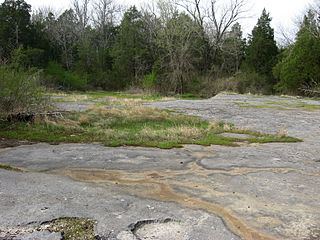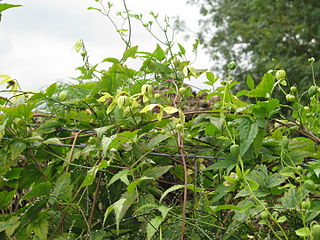
Clematis is a genus of about 380 species within the buttercup family, Ranunculaceae. Their garden hybrids and cultivars have been popular among gardeners, beginning with Clematis 'Jackmanii', a garden staple since 1862; more cultivars are being produced constantly. They are mainly of Chinese and Japanese origin.

Clematis lasiantha, the pipestem clematis, is a creamy-white flowering liana vine, belonging to subgenus Clematis of the large genus Clematis.

Clematis flammula, the fragrant virgin's bower, is a species of flowering plant in the family Ranunculaceae. This deciduous climbing plant is native to southern Europe and northern Africa, but it is cultivated worldwide as an ornamental plant in gardens. It bears fragrant white flowers and small green achenes. When the flowers are newly opened they have a strong sweet almond fragrance. Clematis × aromatica, the scented clematis, is the result of a cross with Clematis integrifolia.

Clematis virginiana is a vine of the Ranunculaceae native to North America from Newfoundland to southern Manitoba down to the Gulf of Mexico. The rationale for some of the common names is unclear, as they include examples normally applied to unrelated plants, including twining parasites. The name "Love Vine" also is applied to alleged aphrodisiacs, such as Caribbean species of Cassytha, which are unrelated to Clematis, not being in the family Ranunculaceae.

A calcareous glade is a type of ecological community that is found in the central Eastern United States. Calcareous glades occur where bedrock such as limestone occurs near or at the surface, and have very shallow and little soil development. Due to the shallow soil and the extreme conditions created by it, trees are often unable to grow in the glades. This creates a habitat that is usually sunny, dry, and hot. Calcareous glade vegetation is more similar to that of a desert habitat than a grassland, being dominated by small spring annuals with occasional geophytic or succulent perennials.

Clematis ligusticifolia is a climbing, spreading vine with showy flowers. It is also known as old-man's beard, yerba de chiva, and virgin's bower,. It is native to North America where it is widespread across the western United States in streamside thickets, wooded hillsides, and coniferous forests up to 8,500 feet (2,600 m).

Bolboschoenus robustus is a species of flowering plant in the sedge family. It is known by many common names: saltmarsh bulrush, alkali bulrush, sturdy bulrush, seacoast bulrush, stout bulrush, three-cornered sedge or leafy three-cornered sedge, and seaside club-rush.

Clematis viticella, the Italian leather flower, purple clematis, or virgin's bower, is a species of flowering plant in the buttercup family Ranunculaceae, native to Europe. This deciduous climber was the first clematis imported into English gardens, where it was already being grown in 1569 by Hugh Morgan, apothecary to Elizabeth I. By 1597, when it was already being called "virgin's bower", there were two varieties in English gardens, a blue and a red.

Thyris fenestrella, commonly known as the pygmy, is a moth of the family Thyrididae.

Tetragonia implexicoma, commonly known as bower spinach, is a species of plant in the Aizoaceae, or ice-plant family. A similar species is Tetragonia tetragonioides, however this species has larger leaves and a shorter flowering time.

Viola selkirkii is a species of violet known by the common names Selkirk's violet and great-spur violet. It is native throughout the Northern Hemisphere, its distribution circumboreal.

Griffiths Island, sometimes incorrectly spelled as Griffith Island or Griffitts Island, lies at the mouth of the Moyne River next to, and within the bounds of, the town of Port Fairy, in the Western District of the state of Victoria in Australia. Griffiths now has no permanent inhabitants, but is connected to the mainland by a causeway and is accessible on foot. It forms part of the Port Fairy and Belfast Coastline Protection Reserve and, as well as being a tourist attraction, is an important site in the context of the history of European settlement of western Victoria. It is managed by the Moyne Shire Council.

Clematis versicolor is a species of flowering plant in the Buttercup family. It is a twining vine native to the Southeastern United States and Ozark Mountains. In this range it is found in scattered calcareous regions, where it is found on limestone outcrops, in thickets, and dry woods. It flowers in the summer.

Clematis drummondii is a species of flowering plant in the buttercup family, Ranunculaceae, that is native to the Southwestern United States and northern Mexico. Common names include old man's beard, Texas virgin's bower, and barba de chivato. It is a white-flowered vine that can be found clambering among other wildflowers, on shrubs and on fence rows. The natural habitat of C. drummondii includes the Chihuahuan Desert and Sonoran Desert, as well as prairies and grasslands. The sap of this plant is caustic, although its foliage, stems, and roots can be used for dye if caution is used while handling and if breathing the fumes is avoided.

Chumash Indian Museum is a Native American Interpretive Center in northeast Thousand Oaks, California. It is the site of a former Chumash village, known as Sap'wi. It is located in Oakbrook Regional Park, a 432-acre park which is home to a replica of a Chumash village and thousand year-old Chumash pictographs. The pictographs by nearby Birthing Cave are not open to the public, but can be observed on docent-led tours. Chumash people inhabited the village 10,000 years ago.

Platanthera dilatata, known as tall white bog orchid, bog candle, or boreal bog orchid is a species of orchid, a flowering plant in the family Orchidaceae, native to North America. It was first formally described in 1813 by Frederick Traugott Pursh as Orchis dilatata.

Clematis serratifolia, the Korean clematis, is a species of flowering plant in the family Ranunculaceae, native to Khabarovsk and Primorsky Krais of the Russian Far East, Manchuria, and the Korean Peninsula. A deciduous climber reaching 3 to 4 m, in the wild it is often found growing in calcareous soils, but can handle acidic soil as well. As an ornamental it is grown for its citrus-like floral aroma and its fluffy seedheads, and is recommended for courtyards, walls, borders, and the like.

Clematis bigelovii, common name Bigelow's clematis, is a perennial climbing plant in the family Ranunculaceae. It grows to approximately 2 feet in height with purple, solitary, bell-shaped flowers. It is native in Arizona and New Mexico and can be found in woodlands and rocky areas.

















